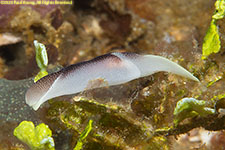 lovely headshield slug, Chelidonura amoena
lovely headshield slug, Chelidonura amoenaWe love sea slugs, but we are not experts on these animals; if you find we have misidentified one, or can identify a specimen we could not, please let us know and we will correct it.
Headshield slugs have a well-developed head shield which is used to plow beneath the surface of the sand. Most have an internal shell.
 lovely headshield slug, Chelidonura amoena
lovely headshield slug, Chelidonura amoena
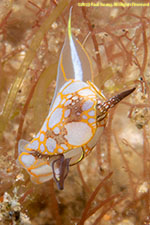 Amusing Siphopteron, Siphopteron nakakatuea
Amusing Siphopteron, Siphopteron nakakatuea
Most Sap-sucking slugs (Sacoglossa) are herbivorous. They have rolled rhinophores. Oral tentacles are small or absent, and gills are usually lacking. They feed primarily on green algae. Many have a symbiotic relationship with the chloroplasts extracted from the algae. Some species feed on nudibranch eggs.
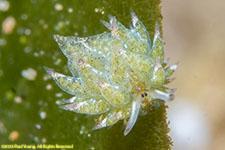 Purple-tipped Costasiella, Costasiella sp.
Purple-tipped Costasiella, Costasiella sp.
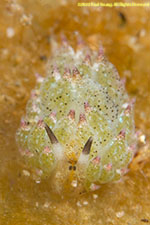
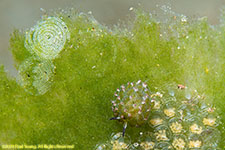 Kuro sap-sucking slug (leaf sheep), Costasiella kuroshimae
Kuro sap-sucking slug (leaf sheep), Costasiella kuroshimae
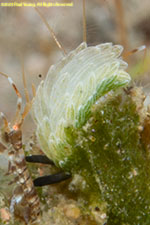 rabbit sap-sucking slug, Costasiella usagi
rabbit sap-sucking slug, Costasiella usagi
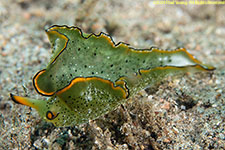 ornate sap-sucking slug, Elysia marginata
ornate sap-sucking slug, Elysia marginata
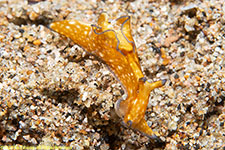 Freckled sea hare, Aplysia parvula (nigrocincta)
Freckled sea hare, Aplysia parvula (nigrocincta)
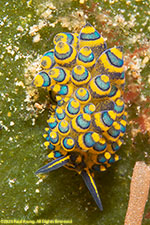 Ornate Stiliger, Stiliger ornatus
Ornate Stiliger, Stiliger ornatus
True sea slugs (nudibranchs) are carnivores. In most species the gills or branchial plumes are outside the body. All have rhinophores.
Dorid nudibranchs (Doridacea) have a mantle which overlaps the sides of the foot. Most have a ring of external branched gills surrounding the anus towards the back of the body. Some species instead have the gills located beneath the sides of the mantle. Most species can withdraw their rhinophores into a pocket beneath the skin.
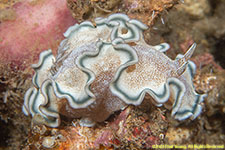 Hikueru glossodoris, Glossodoris hikuerensis
Hikueru glossodoris, Glossodoris hikuerensis
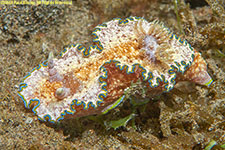 Girdled glossodoris, Glossodoris cincta
Girdled glossodoris, Glossodoris cincta
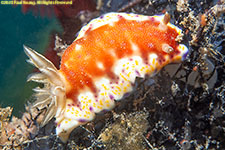 Collingwood's chromodoris, Chromodoris collingwoodi (Goniobranchus collingwoodi)
Collingwood's chromodoris, Chromodoris collingwoodi (Goniobranchus collingwoodi)
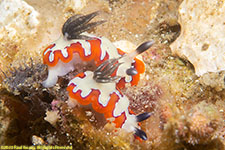 Creamy nudibranch, Goniobranchus (Chromodoris) fidelis
Creamy nudibranch, Goniobranchus (Chromodoris) fidelis
 Green ring nembrotha, Nembrotha yonowae
Green ring nembrotha, Nembrotha yonowae
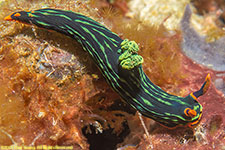
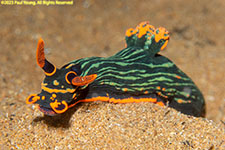 Kubaryana's nembrotha, Nembrotha kubaryana
Kubaryana's nembrotha, Nembrotha kubaryana
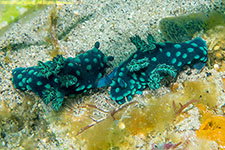 Crested nembrotha, Nembrotha cristata
Crested nembrotha, Nembrotha cristata
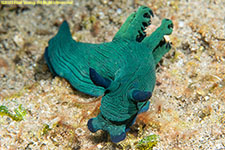 Miller's nembrotha, Nembrotha milleri
Miller's nembrotha, Nembrotha milleri
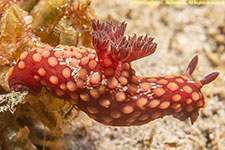 Strawberry gymnodoris, Gymnodoris aurita
Strawberry gymnodoris, Gymnodoris aurita
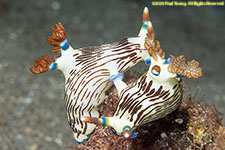 Lined nembrotha, Nembrotha lineolata
Lined nembrotha, Nembrotha lineolata
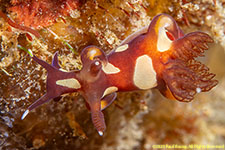 Jester trapania, Trapania scurra
Jester trapania, Trapania scurra
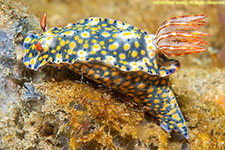 Fire Hypselodoris, Hypselodoris infucata
Fire Hypselodoris, Hypselodoris infucata
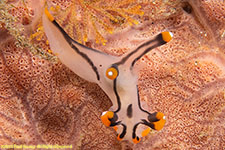
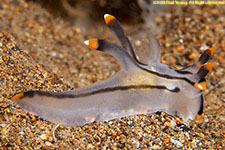 Painted thecacera, Thecacera picta
Painted thecacera, Thecacera picta
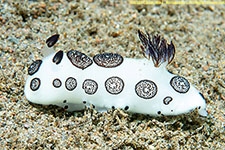 Funeral (mourning) jorunna, Jorunna funebris
Funeral (mourning) jorunna, Jorunna funebris
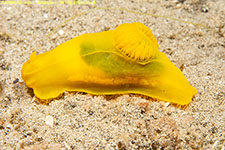 Yellow-guts gmnodoris, Gymnodiris aff. citrina
Yellow-guts gmnodoris, Gymnodiris aff. citrina
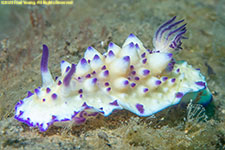 Bumpy mexichromis, Mexichromis multituberculata
Bumpy mexichromis, Mexichromis multituberculata
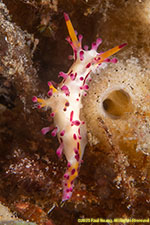 hairy Norse god, (shaggy aegires), Aegires villosus
hairy Norse god, (shaggy aegires), Aegires villosus
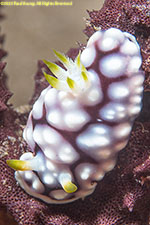
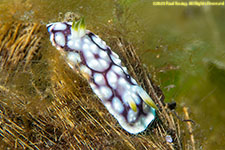 Geometric nudibranch, Goniobranchus geometricus
Geometric nudibranch, Goniobranchus geometricus
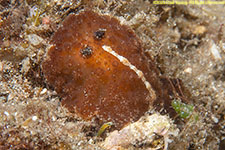 White stripe atagema, Trippa (Atagema) intecta
White stripe atagema, Trippa (Atagema) intecta
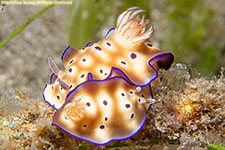 Kunei's nudibranch, Goniobranchus kuniei
Kunei's nudibranch, Goniobranchus kuniei
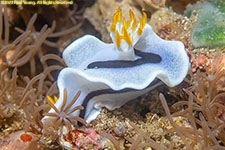 Diana's chromodoris, Chromodoris dianae
Diana's chromodoris, Chromodoris dianae
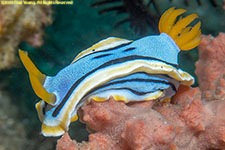
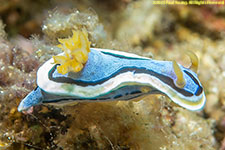 Michael's chromodoris, Chromodoris michaeli
Michael's chromodoris, Chromodoris michaeli
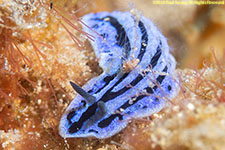 Anna's Phyllidiopsis, Phyllidiopsis annae
Anna's Phyllidiopsis, Phyllidiopsis annae
 Sky Blue Phyllidea, Phyllidea coelestis
Sky Blue Phyllidea, Phyllidea coelestis
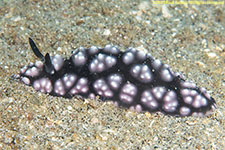
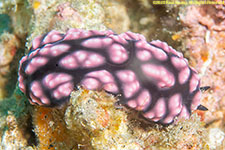 Ppimpled phyllidiella, Phyllidiella pustulosa
Ppimpled phyllidiella, Phyllidiella pustulosa
Dendrontid nudibranchs (Dendronotidae) have elongated bodies, often with numerous branching cerrata on their dorsal side which lack extensions from their digestive gland. The head has an oral veil having branching extensions. The lamellate rhinophores are surrounded by a sheath and branched extensions.
Arminid nudibranchs (Arminidae) are the smallest suborder of nudibranchs. Most have a cephalic veil and contractile rhinophores without sheaths or pockets. Gills may be present or absent, They feed on soft corals and sea pens or bryozoans.
Aeolid nudibranchs (Aeolidida) have elongated, tapering bodies with cerrata containing cnidosacs. This is the second largest nudibranch suborder. They lack distinct gills and use cerrata for respiration and defense.
 Blue dragon,Pteraeolidia semperi
Blue dragon,Pteraeolidia semperi
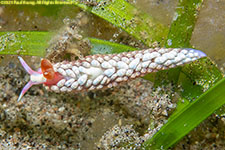 White-faced babakina, Babakina indopacifica
White-faced babakina, Babakina indopacifica
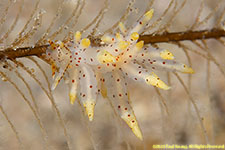 Dalmatian Eubranchus, Eubranchus sp.
Dalmatian Eubranchus, Eubranchus sp.
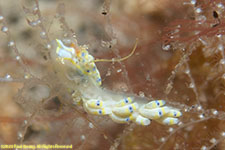 Blue-banded trichesia, Trichesia sp.
Blue-banded trichesia, Trichesia sp.
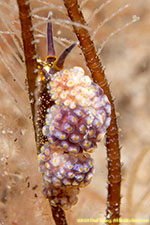 Yellow-tipped doto, Doto cf ussi
Yellow-tipped doto, Doto cf ussi
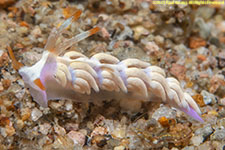
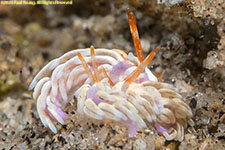 Purple Trinchesia, Trinchesia sp.
Purple Trinchesia, Trinchesia sp.
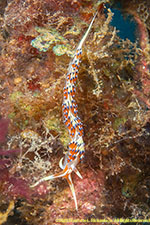 Indian caloria, Caloria indica
Indian caloria, Caloria indica
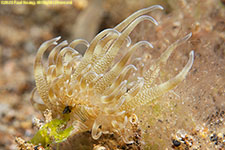 Jakobsen's phyllodesmium, Phyllodesmium jakobsenae
Jakobsen's phyllodesmium, Phyllodesmium jakobsenae
©2023 Mermaid Underwater Photographic. All Rights Reserved.
Contact us at mermaid@underwater.org.
Last modified 24 April 2023